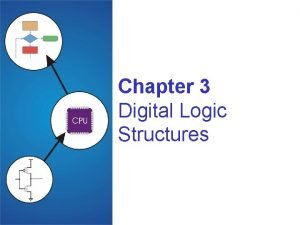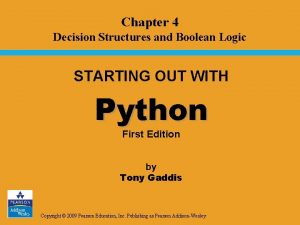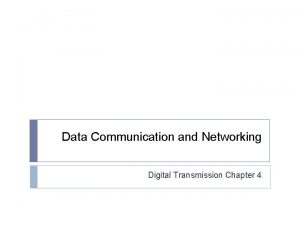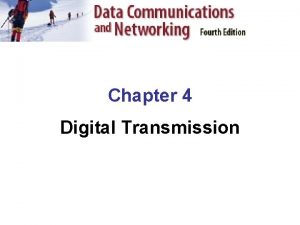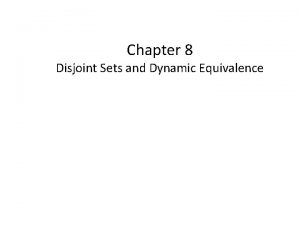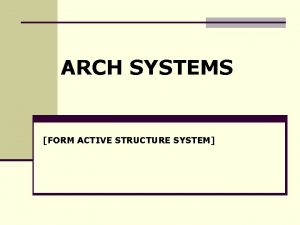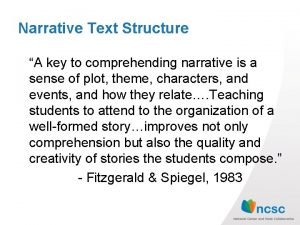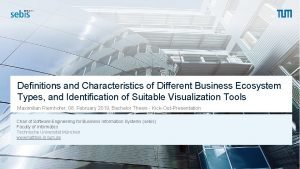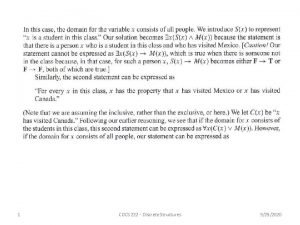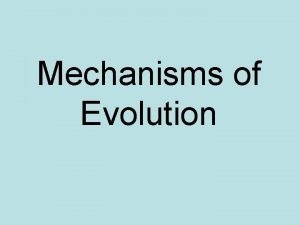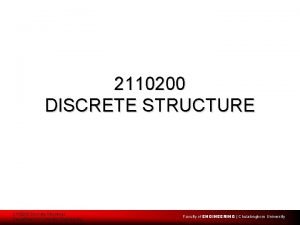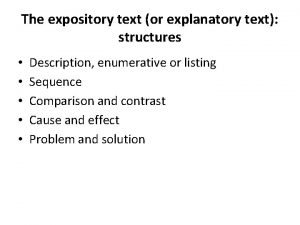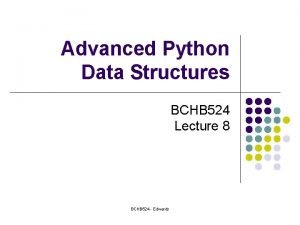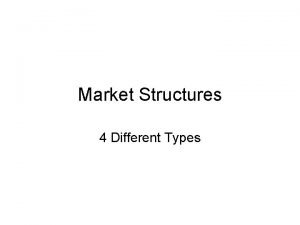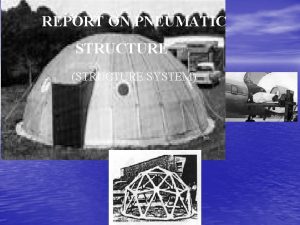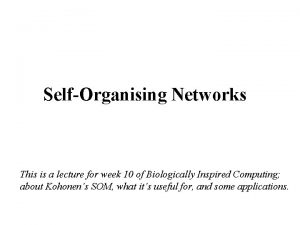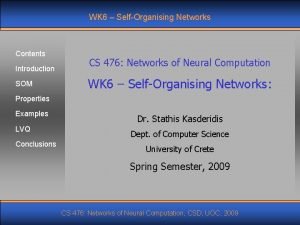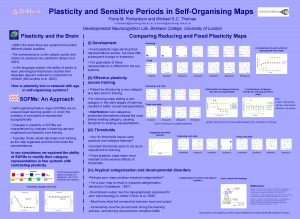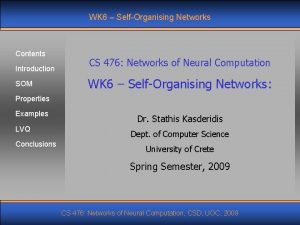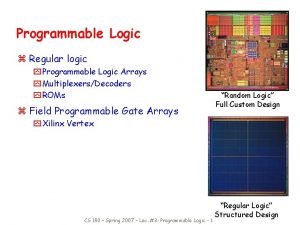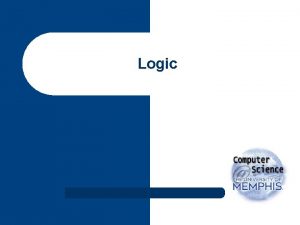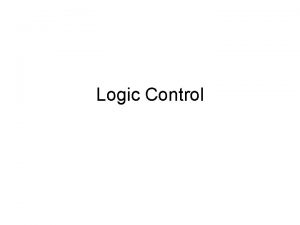Selforganising Logic of Structures as an Element of











![Examples of Links Creation • Anaphora S 1[A farmer owns a donkey. ] S Examples of Links Creation • Anaphora S 1[A farmer owns a donkey. ] S](https://slidetodoc.com/presentation_image/97e82034fbb4f677b05be8dcb8565a19/image-12.jpg)
















- Slides: 28

Self-organising Logic of Structures as an Element of the Multi-layered Language Description Maciej Piasecki G 4. 19 Research Group Institute of Informatics Wrocław University of Technology nlp. pwr. wroc. pl

Plan of the talk • Problem, goals and ideas • Self-organising Logic of Structures and the notion of state • Representation of context dependencies • Cardinality Dependency instead of Scope in multiple quantifiers sentences • Compositional, linear and incremental interpretation of the discourse • SLS-based interpretation in the MIC perspective

Assumption • Compositionality in Montagovian sense „The meaning of a complex expression is a function of the meanings of its parts, and the syntactic rules by which they are combined. ” (Partee & al, 1993) • Attractive for Formal Semantics • Attractive for the applications in Language Technology

Problem • Anaphora in Dynamic Semantics (e. g. DRT) A man 1 is walking in the park. x, y man(x) park(y) walk_in(x, y) He 1 is whistling. x, y, z man(x) park(y) walk_in_park(x) x=z • Pre-semantic interpretation? gen(z, male) whistle(z) Prior knowledge about anaphoric links is a necessary condition for the proper selection of discourse referents

Goals • Strictly compositional construction of discourse representation Following the main lines of Dynamic Semantics. • Elimination of the dependency of the construction process on the syntactic indexes Resulting in elimination of the use of Discourse Referent names. • Scope-less representation of ‘multiple quantifiers’ sentences

Ideas • Main aspects of the NP meaning: – interaction with the context (anaphora, reference, presupposition, etc. ) – quantification (including relations among quantifier) – and descriptional content • The aspects are independent but cooperating • Anaphora representation on the basis of syntactic indexing is not the appropriate way to do this

Self-organising Logic of Structures • SLS A typed logical language, where all operators are abbreviations of the expressions of the simple core sub-language of many sorted typed logic. • Primitive types: – e (entities) De , t (truth values) Dt = {0, 1} – m (discourse referents – DR – metaphor of memory) • Dm = any infinite set – unlimited ‘amount of memory’, • <M – a total order defined on Dm • minimal element P 0, p Dm. (P 0<M p P 0=p) • Construction of compound types – (a b), where D(a b) = Db. Da – (a 1 a 2. . . an), where =

SLS – the Notion of State • State – a compound type s = ( m ((m m)t) (m(et)) ) – Initial state S 0 = P 0, , { P 0, } – Meaning = relation on states discourse referents ‘memory’: assignment in the state the most recently activated next discourse referents to be activated or activated earlier links

SLS – Context Dependencies(1) • Dynamic formulae: – Terms of the type (s(st)) – relations on states – Test or change input states – Semantic representation of sentences and discourses • Discourse referent activation – – operator of the type (s(st)) – Changes the most recently activated DR to the next one – Assigns it some value in each of the output states operator one of the output states input state P 0 . . . Pn Pn+1 assignment of a value

SLS – Context Dependencies(2) • Reference operator – For the given DR and ‘a class’ generates a relation on states – Finds all appropriate DRs, such that: • They are accessible (i. e. activated) in the given state – structural condition • And their values belong to the given class (simplified semantic subsumption) – semantic condition – Adds a link from the given DR to each of the appropriate DRs – In the case of at least one pair, both DRs must be assigned the same value (indeterministic interpretation of reference) operator (Pn , X ) input state P 0 . . . Pn X = P 0 output state . . . Pk . . . Pi . . . Pn Yk X Yi X X =

SLS – Context Dependencies (3) • Accessibility of DRs – In each state, the set of accessible = the set of activated – Operators of: dynamic negation (not), implication ( ) i disjunction (or) – Can exclude some DRs from the set of activated – Sequential merging operator (; ) preserves activation of DRs • ‘Access operators’ returning (for the given state): – The most recently activated DR (operator ) – And the operator # getting value of the given DR from the given state – E. g. li. lj. (#( (i), i) man Ů i=j) represents a test on the input state
![Examples of Links Creation Anaphora S 1A farmer owns a donkey S Examples of Links Creation • Anaphora S 1[A farmer owns a donkey. ] S](https://slidetodoc.com/presentation_image/97e82034fbb4f677b05be8dcb8565a19/image-12.jpg)
Examples of Links Creation • Anaphora S 1[A farmer owns a donkey. ] S 2[He likes it. ] – Simplified representation of S 1 li. lj. ( Ż(i, k 1) ; farmer(#(Ń(k 1), k 1)) Ů k 1=k 2 ; Ż(k 2, k 3) ; donkey(#(Ń(k 3), k 3)) Ů k 3=k 4 ; own( #(Ń(k 1), #(Ń(k 3), k 3) ) Ů k 4=j) – Simplified representation of the discourse li. lj. (Ż(i, k 1); farmer(#(Ń(k 1), k 1)) Ů k 1=k 2 ; Ż(k 2, k 3) ; donkey(#(Ń(k 3), k 3)) Ů k 3=k 4; own( #(Ń(k 1), #(Ń(k 3), k 3)) Ů k 4=k 5 ; Ż(k 5, k 6) ; (Ń(k 6), male_pron, k 6, k 7) ; Ż(k 7, k 8) ; (Ń(k 8), non_hum_pron, k 8, k 9) ; like( #(Ń(k 6), j), #(Ń(k 8), j) ) Ů k 7=j)

Existential presupposition • Representation – Modifiers of the reference operator: (strict presupposition) (weak presupposition), – Blocking the generation of the output state in case the reference operator can not create the enough number of links, respectively: exactly one / at least one, – E. g. Jan zdobył pewną górę. Jan climbed a (certain) mountain. li. lj. (Ż(i, k 1) ; ( ) (Ń(k 1), named_jan, k 1, k 2) ; Ż(k 2, k 3) ; ( ) (Ń(k 3), mountain, k 3, k 4) ; mountain(#(Ń(k 4), k 4)) Ů k 4=k 5 ; climb( #(Ń(k 1), #(Ń(k 4), k 4) ) Ů k 5=j) – E. g. ||tą górę (the/this mountain)||= li. lj. (Ż(i, k 1); ( ) (Ń(k 1), mountain, k 1, k 2) ; mountain(#(Ń(k 2), k 2))Ůk 2=j ) – And in the case of jakąś górę (a mountain) no operator

Varieties of Quantification • Proto-quantifiers – functors of type ((et) t)) Producing a Generalised Quantifier (i. e. set of sets) • Variety modifiers (following van der Does, 1994) E. g. let X=#( (i), i) be the value of some DR three( X ) . . . collective C 2(three)(X) a . . . neutral N 2(three)(X) . . . distributive D 1(three)(X) . . .

Cardinality Dependency in SLS • Binary directed relations between GQs Operators of cardinality: dependency (‘<‘) and indepedency (‘: ‘) Qthree<Qtwo • Quantification structures in a sentence (phrase) configurations of collections modified proto-quantifiers = the possible structures of relation and their dependencies matrix operator Q <Q three two Qtwo>Qthree

Representation of Simple Sentence • Verb predicates denotation – Type ((et)i t) t), where i is a number of arguments – A set of configurations of collections The configurations correspond to some set of eventualities , , ,

Truth Value of Simple Sentence = Intersection matrix operator the set of potential configurations of collections verb predicate denotation , , all and only objects from the values of the given DRs ,

Representation of Multiple Quantifiers Sentence e. g. Three professors marked two papers. • Semantic representation (simplified a little): – distributive, ‘wide scope’ reading of three professors i. j. ( (i, k 1) ; #( (k 1), k 1) professor k 1=k 2 ; (k 2, k 3); #( (k 3), k 3) paper k 3=k 4 ; 2 ( intersection operator 2( , , marked), filtered verb predicate M 2( <, >, sequence D 1(three)( #( (k 1), j) ) ), D 1(two)( #( (k 3), j) ) of dependency ), #( (k 1), l), #( (k 3), j) operators ) k 4 = j ) – other readings: >, < — narrow scope three professors, : , : — independency, a kind o cumulative reading, <, < — a kind of branching quantification.

Examples: Simple Discourse More than two men laugh. They respect some young boy. (van Eijck & Nouven, 2002) • Interpretation of the first sentence: activated DR (D 1(more_than_two))(X)= atomic collection state: assignment X= X man set of objects validating intersection (‘situation’) = ||laugh||

Examples: Simple Discourse More than two men laugh. They respect some young boy. (van Eijck & Nouven, 2002) • Interpretation of the second sentence: link X= ( (D 1(exstpl))(Z) < (D 1(some))(Y) ) =Z Y= Y young_boy = ||respect|| validating intersection

SLS: Semantic vs Pragmatic Aspects • SLS crosses the border between semantics and pragmatics, e. g. – Reference operator: searches across ordered list of discourse referents – Presupposition operators: constrain results produced reference operator – Initial state: ordered list of discourse referents + assignments • SLS operators define the schemes, not the full-fledged implementation, – E. g. neither linguistic structure nor speaker focus are not implemented in the reference operator – SLS must be augmented with respect to the pragmatic level

SLS in the Meta-Informative Grounding Perspective (1) • Meta-informative structure of the state – linguistic structure – anaphora resolution – Centres of Attention – order of discourse referents and their accessibility – knowledge structures – presupposition accommodation operator (Pn , X ) input state P 0 . . . Pn X = P 0 output state . . . Pk . . . Pi . . . Pn Yk X Yi X X =

SLS in the Meta-Informative Grounding Perspective (2) • Mapping: linear linguistic structure – dependency structure – verb predicate – semantic interpretation of arguments i. j. ( (i, k 1) ; #( (k 1), k 1) professor k 1=k 2 ; (k 2, k 3); #( (k 3), k 3) paper k 3=k 4 ; 2( , , marked), M 2( <, >, D 1(three)( #( (k 1), j) ) ), D 1(two)( #( (k 3), j) ) ), #( (k 1), l), #( (k 3), j) ) k 4 = j )

SLS in the Meta-Informative Grounding Perspective (3) • Mapping: meta-information – structure of cardinality dependencies – quantification variety – intended by the speaker configurations of collections modified proto-quantifiers = the possible structures of relation and their dependencies matrix operator Q <Q three two Qtwo>Qthree

SLS in the Meta-Informative Grounding Perspective (4) • Assignments vs verb interpretation in grounding – situations (configurations of collection) represented by the verb • Assignments vs grounding – communicative grounding • restrictions on assignments and Centres of Attention • meta-informative validation – ontological grounding – contextually sensitive interpretation of predicates

Discourse Interpretation as A Problem of Constraints Satisfaction • Intra-sentential level – The denotation of verbal predicate must satisfy the constraint introduced by the nominal part i. e. the constraints defining the set of possible configurations of collections • Inter-sentential level – A ‘chain’ of constraints – Linked by referential links

Conclusions • Expressions of SLS ‘look for’ binding with the previous expressions by the virtue of their properties. • Linking in SLS tries to mimic linking in natural language. • SLS more manipulates structures of objects than assignments. • The structures organise themselves from ‘inside’. • Further enrichment of the state and multi-level SLS interpretation are required. Work co-financed by the European Union Innovative Economy Programme project NEKST POIG. 01. 02 -14 - 013/09

Variable Free, Binding Free and Structure Oriented Discourse Compositional Interpretation Thank you very much for your attention. . . Maciej Piasecki G 4. 19 Research Group Institute of Informatics Wrocław University of Technology
 Homologous structures definition
Homologous structures definition Digital logic structures
Digital logic structures Python decision structures
Python decision structures First order logic vs propositional logic
First order logic vs propositional logic Combinational logic sequential logic
Combinational logic sequential logic Combinational logic circuit vs sequential
Combinational logic circuit vs sequential Combinational logic sequential logic 차이
Combinational logic sequential logic 차이 First order logic vs propositional logic
First order logic vs propositional logic Tw
Tw If x = 0 and y = 1, which output line is enabled?
If x = 0 and y = 1, which output line is enabled? First order logic vs propositional logic
First order logic vs propositional logic Project management plan example
Project management plan example Difference between signal element and data element
Difference between signal element and data element Signal element vs data element
Signal element vs data element Accessory visual structures
Accessory visual structures Smart union algorithm in data structure
Smart union algorithm in data structure Homologous defintion
Homologous defintion Section active structure
Section active structure Waterloo data structures and algorithms
Waterloo data structures and algorithms Structures of narrative text
Structures of narrative text Characteristics of business ecosystem
Characteristics of business ecosystem Cs 584
Cs 584 Directional selection
Directional selection 2110200
2110200 What is an explanatory text
What is an explanatory text Advanced data structures in python
Advanced data structures in python School organizational structure and functions
School organizational structure and functions Goods definition
Goods definition Pneumatic structure system
Pneumatic structure system

